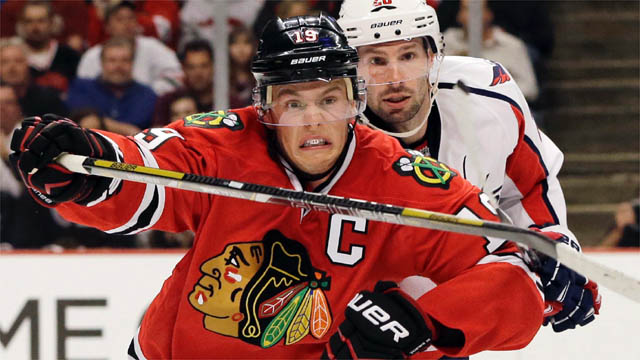There is no longer a debate about East vs. West in the NHL. In fact, with Western-based teams holding a 125-58-24 record (a .662 points percentage) against inter-conference opponents through Thursday’s play, there isn’t even room for any meaningful discussion.
Yet the numbers don’t really address an important question: How did this happen?
Of all the theories I’ve recently heard from those on both sides of the continent, the most interesting one came courtesy of Blackhawks GM Stan Bowman. He points to the way the top Western Conference teams were built and notes that the core players in every situation have all been in place for at least a couple years.
Consider the fundamental makeup of the following five Western Conference powers: Chicago (Toews/Kane/Hossa/Sharp/Keith/Seabrook); Anaheim (Getzlaf/Perry/Fowler/Beauchemin); Los Angeles (Kopitar/Brown/Williams/Carter/Richards/Doughty); St. Louis (Backes/Steen/Oshie/Pietrangelo/Shattenkirk); and San Jose (Thornton/Marleau/Couture/Pavelski/Boyle/Vlasic). The majority of those players were drafted and developed by their current organization and all of them have spent two or three seasons, at minimum, playing together. No wonder their teams are better organized as a five-man unit than what’s typically seen in the East. The quality of players mentioned certainly helps, too.
The other more obvious point is that they have to go through each other to have any success. When the lockout ended in January, every game was played within the conference, so a total of 18 months passed between regular-season meetings involving West and East teams leading into the current season. During that time, the Kings (2012) and Blackhawks (2013) each hoisted the Stanley Cup while playing a very specific brand of puck-possession hockey.
“This has nothing to do with East vs. West. This has everything to do with Los Angeles and Chicago,” says Blues coach Ken Hitchcock, before adding that every West team tailors their roster to beat those teams. This is as deep as I’ve ever seen it. I’ve never seen the West like this, where I think there’s eight or nine or 10 teams talking about `If everything goes well, we might have a chance here.’ This is going to be an absolute mindfield to get through, just to get into the playoffs.”
Goaltender Jonathan Bernier had spent his entire NHL career learning one type of pro hockey in Los Angeles before getting traded to Toronto over the summer. He’s been amazed at the difference. Bernier notes that even the best of the best in the East rarely play a style that is designed to grind out a 2-1 victory (based on what he’s seen, he thinks Boston might be closest).
Part of that difference might simply come down to the fact that many of the NHL’s top offensive talent found its way to Eastern teams — players like Alex Ovechkin, Sidney Crosby, Evgeni Malkin, Steven Stamkos, John Tavares and others. Even though some of those guys have shown themselves to be reliable two-way players in the playoffs, they aren’t usually called on to play both sides of the ice quite so much during the regular season. “It makes a huge difference when guys are committed to playing defensive and they realize how important it is to be a both ways player,” says Bernier.
That might be one of the built-in benefits of playing out West. If you want to have a winning team, you have no choice. And Phoenix Coyotes coach Dave Tippett, for one, believes that his players benefit by having to constantly face top quality competition. “We know if we get into a game there can’t be any low spots in your game or you’re going to lose,” says Tippett.
However, he also woke up Friday morning and found his Coyotes on pace for 101 points and still chasing the final wild card spot in the conference. That won’t necessarily be any different in April, either. “I think it’s going to be way over 100 points before you’re going to get into the playoffs in the West, which is hard to fathom,” says Hitchcock.
SLIDING SENS
Everything seems to be heading in the wrong direction for the Ottawa Senators, a team struggling to climb back into the Eastern Conference playoff race and one that captain Jason Spezza referred to as “fragile” after a third loss in four games on Thursday night. Here is one more sign of the tough times: 17,375.
That is the average attendance at Canadian Tire Centre through 20 home games this season — a number that has dropped by 2,000 from the lockout-shortened 2013 campaign. While the Sens attribute the decline to fewer promotional giveaways, team president Cyril Leeder acknowledged during a recent conversation that the organization is currently facing some challenges.
One of the biggest issues is a December schedule that features a team-record 11 games at home. The Sens have seen below-average crowds for the last five of those: Dec. 9 vs. Philadelphia (15,786), Dec. 12 vs. Buffalo (15,578), Dec. 14 vs. Los Angeles (17,140), Monday vs. St. Louis (16,008) and Thursday vs. Florida (15,927). Overall, Leeder estimated that the glut of December games left the team with 80,000 tickets to sell over and above its season-ticket base. That is a tough ask.
The Senators are currently operating about $8-million below the $64.3-million salary cap — giving them one of the NHL’s cheapest payrolls — and there have been some whispers in the industry that Sens GM Bryan Murray might have to cut salary before the end of the season if the losing continues. “I don’t see any scenario where (that will happen),” says Leeder. “I’ve been here for all 23 years and our payroll has gone up every year. When you retool you’re going to dip a little bit, but we’re where we thought we’d be — we’ve got to have a payroll that’s consistent with the age of our players as well.We need to have room to grow to keep those guys over time.”
One excuse he won’t accept for the poor performance at the box office is the poor performance on the ice. The Sens are just 7-10-3 at home and will need a big turnaround to get back to the playoffs for a third straight season. “Our job is to fill the building up whether the team goes 82-0 or 0-82,” said Leeder. “You’re never happy when there’s an empty seat.” An empty seat is not something you’re likely to find in any other Canadian arena. Montreal, Toronto, Winnipeg, Vancouver and Calgary are all at capacity or above it this season while Edmonton has filled 99.8 per cent of its seats so far.
A FEW MORE THINGS
The NHL is now closed for business until Dec. 28 — at least as it pertains to player moves. Team rosters have been frozen for the holidays, with the only exception being call-ups from the American Hockey League. You might not notice much of a difference: Trades have been extremely rare this season with 13 teams pushing up against a salary cap that dropped for the first time in NHL history over the summer. Business reopens Dec. 28at 12:01 a.m.
The search for a new GM continues in both Calgary and Buffalo and there’s no reason to expect any big announcements soon. Industry sources suggest that neither Brian Burke nor Pat LaFontaine is any rush to make a hire. LaFontaine, the Sabres president of hockey operations, has already been evaluating candidates for more than a month and could still end up adding the GM’s role to his current title. Burke seems far less inclined to keep the Flames job for himself over the long term, but he’ll have no trouble handling it until he adds someone else to the front office.
It will never go down as a near miss for 50-in-50. No, Alex Ovechkin hasn’t truly been chasing one of hockey’s toughest milestones for the past nine months. But entering play Friday, the Washington Capitals sniper had 47 goals in his past 50 regular-season games dating back to March 22 and that’s pretty amazing in its own right. When you consider that no other player has more than 43 goals in the entirety of the past two seasons combined — Ovechkin has 60 over that span — the dominance of the Great 8 is something to behold. And with the Sochi Olympics on the horizon, it couldn’t come at a better time.
The Chicago Blackhawks could go where no team has gone for more than 15 years by repeating as Stanley Cup champions this season. A big key to the early success of the NHL’s top team — 25-7-5 entering a game against Vancouver Friday — has been the lessons learned following their 2010 championship. Veteran forward Patrick Sharp remembers what a struggle it was to make the playoffs and believes that Chicago’s other core players do as well. “We basically have the same team as we had last year so it’s a little easier to pick up where we left off,” he says. The Blackhawks have come up with a systematic way to approach a long regular season. “Every game is meaningful, but they only get more meaningful as the playoffs come and that’s a long way away,” says Sharp. “You’ve got to get better every month — that’s what we’ve been trying to do.” So far, so good.
No team will see more money from the NHL’s new Canadian TV rights deal than the Toronto Maple Leafs. That’s because the league’s Canadian-based clubs are reimbursed for TV blackout periods where they’re forbidden from playing — the Ottawa Senators, for example, can’t currently host a Saturday night game unless CBC is broadcasting it — and the size of those payments is based on the size of the market the team plays in. Toronto is the largest one of those in Canada. Once the blackout payments are made, the NHL’s 30 teams split the remainder of the pot equally — which means that all 23 U.S.-based teams receive the same amount.
The Pittsburgh Penguins just keep on winning despite currently playing without five of their top-six defencemen, plus offensive stars Evgeni Malkin and James Neal, among others. One of the recent bright spots has been the emergence of 19-year-old defenceman Olli Maata, who logged a career-high 28:06 during a win over the Rangers at Madison Square Garden earlier this week. Maata has come a long way in a short amount of time. Back in September, he was viewed as a player who was likely going to spend the holidays representing Finland at another World Junior Championship. Instead, he’s a core member of the Eastern Conference’s top team and is almost certainly headed to the Sochi Games in February.
GIFT IDEA?
With the holiday season in full swing, here is a last-minute book recommendation for the hockey fan on your shopping list: This is Russia by Bernd Bruckler and Risto Pakarinen. Bruckler, a former Philadelphia Flyers draft pick, offers a fascinating first-person look at life in the KHL for a foreigner (with assistance from Pakarinen, a Stockholm-based journalist). The Austrian goalie spent three seasons in Russia and details everything from the unusual training methods to excessive pill taking to the Russian party scene.
Top of the season to one and all.

